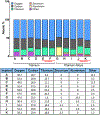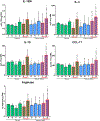Surface characteristics on commercial dental implants differentially activate macrophages in vitro and in vivo
- PMID: 33502059
- PMCID: PMC8207525
- DOI: 10.1111/clr.13717
Surface characteristics on commercial dental implants differentially activate macrophages in vitro and in vivo
Abstract
Objectives: Biomaterial implantation provokes an inflammatory response that controls integrative fate. M2 macrophages regulate the response to implants by resolving the inflammatory phase and recruiting progenitor cells to aid healing. We have previously shown that modified titanium (Ti) disks directly induce M2 macrophage polarization. The aim of this study was to examine macrophage response to commercially available Ti or Ti alloy implants with comparable roughness and varying hydrophilicity.
Material and methods: Eleven commercially available Ti (A-F) or Ti alloy (G-K) dental implants were examined in this study. Surface topography, chemistry, and hydrophilicity were characterized for each implant. To compare the immune response in vitro, human monocyte-derived macrophages were seeded on implants and secreted pro- and anti-inflammatory proteins measured. To evaluate the inflammatory response in vivo, mice were subcutaneously instrumented with clinical implants, and implant adherent macrophage populations were characterized by flow cytometry.
Results: Macrophages on hydrophobic Implant C produced the highest level of pro-inflammatory proteins in vitro. In contrast, hydrophilic Implant E produced the second-highest pro-inflammatory response. Implants F and K, both hydrophilics, produced the highest anti-inflammatory protein secretions. Likewise, pro-inflammatory CD80hi macrophages predominated in vivo on implants C and E, and M2 CD206 + macrophages predominated on implants F and K.
Conclusions: These findings show that hydrophilicity alone is insufficient to predict the anti-inflammatory effect on macrophage polarization and that other properties-surface composition or topography-determine immune modulation. This in vivo model may be a useful screening method to compare the immunomodulatory response to clinical implants of disparate geometry or size.
Keywords: hydrophilicity; inflammation; macrophages; surface chemistry.
© 2021 John Wiley & Sons A/S. Published by John Wiley & Sons Ltd.
Figures





Similar articles
-
Macrophage behavior and interplay with gingival fibroblasts cultured on six commercially available titanium, zirconium, and titanium-zirconium dental implants.Clin Oral Investig. 2019 Aug;23(8):3219-3227. doi: 10.1007/s00784-018-2736-z. Epub 2018 Nov 10. Clin Oral Investig. 2019. PMID: 30415441
-
Titanium surface characteristics, including topography and wettability, alter macrophage activation.Acta Biomater. 2016 Feb;31:425-434. doi: 10.1016/j.actbio.2015.12.003. Epub 2015 Dec 7. Acta Biomater. 2016. PMID: 26675126 Free PMC article.
-
Novel in vitro comparative model of osteogenic and inflammatory cell response to dental implants.Dent Mater. 2019 Jan;35(1):176-184. doi: 10.1016/j.dental.2018.11.011. Epub 2018 Nov 30. Dent Mater. 2019. PMID: 30509481
-
Surface Topography Steer Soft Tissue Response and Antibacterial Function at the Transmucosal Region of Titanium Implant.Int J Nanomedicine. 2024 May 27;19:4835-4856. doi: 10.2147/IJN.S461549. eCollection 2024. Int J Nanomedicine. 2024. PMID: 38828200 Free PMC article. Review.
-
Titanium Implant Surface Effects on Adherent Macrophage Phenotype: A Systematic Review.Materials (Basel). 2022 Oct 19;15(20):7314. doi: 10.3390/ma15207314. Materials (Basel). 2022. PMID: 36295379 Free PMC article. Review.
Cited by
-
Contribution of αβ T cells to macrophage polarization and MSC recruitment and proliferation on titanium implants.Acta Biomater. 2023 Oct 1;169:605-624. doi: 10.1016/j.actbio.2023.07.052. Epub 2023 Aug 1. Acta Biomater. 2023. PMID: 37532133 Free PMC article.
-
3D printing of different fibres towards HA/PCL scaffolding induces macrophage polarization and promotes osteogenic differentiation of BMSCs.PLoS One. 2025 Jan 13;20(1):e0314150. doi: 10.1371/journal.pone.0314150. eCollection 2025. PLoS One. 2025. PMID: 39804888 Free PMC article.
-
Electrospun Fiber Surface Roughness Modulates Human Monocyte-Derived Macrophage Phenotype.bioRxiv [Preprint]. 2024 Sep 3:2024.08.30.610568. doi: 10.1101/2024.08.30.610568. bioRxiv. 2024. PMID: 39282362 Free PMC article. Preprint.
-
Cytotoxicity and antibacterial susceptibility assessment of a newly developed pectin-chitosan polyelectrolyte composite for dental implants.Sci Rep. 2024 Jul 23;14(1):16968. doi: 10.1038/s41598-024-68020-7. Sci Rep. 2024. PMID: 39043806 Free PMC article.
-
Immune cell response to orthopedic and craniofacial biomaterials depends on biomaterial composition.Acta Biomater. 2023 Apr 15;161:285-297. doi: 10.1016/j.actbio.2023.03.007. Epub 2023 Mar 9. Acta Biomater. 2023. PMID: 36905954 Free PMC article.
References
-
- Biguetti CC, Cavalla F, Silveira EM, Fonseca AC, Vieira AE, Tabanez AP, Rodrigues DC, Trombone APF, & Garlet GP (2018). Oral implant osseointegration model in C57Bl/6 mice: microtomographic, histological, histomorphometric and molecular characterization. Journal of Applied Oral Science : Revista FOB, 26, e20170601. 10.1590/1678-7757-2017-0601 - DOI - PMC - PubMed
MeSH terms
Substances
Grants and funding
LinkOut - more resources
Full Text Sources
Other Literature Sources

